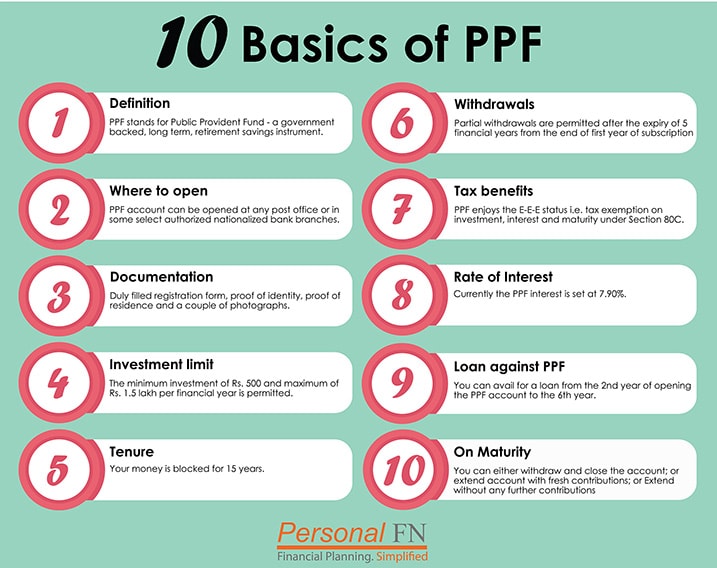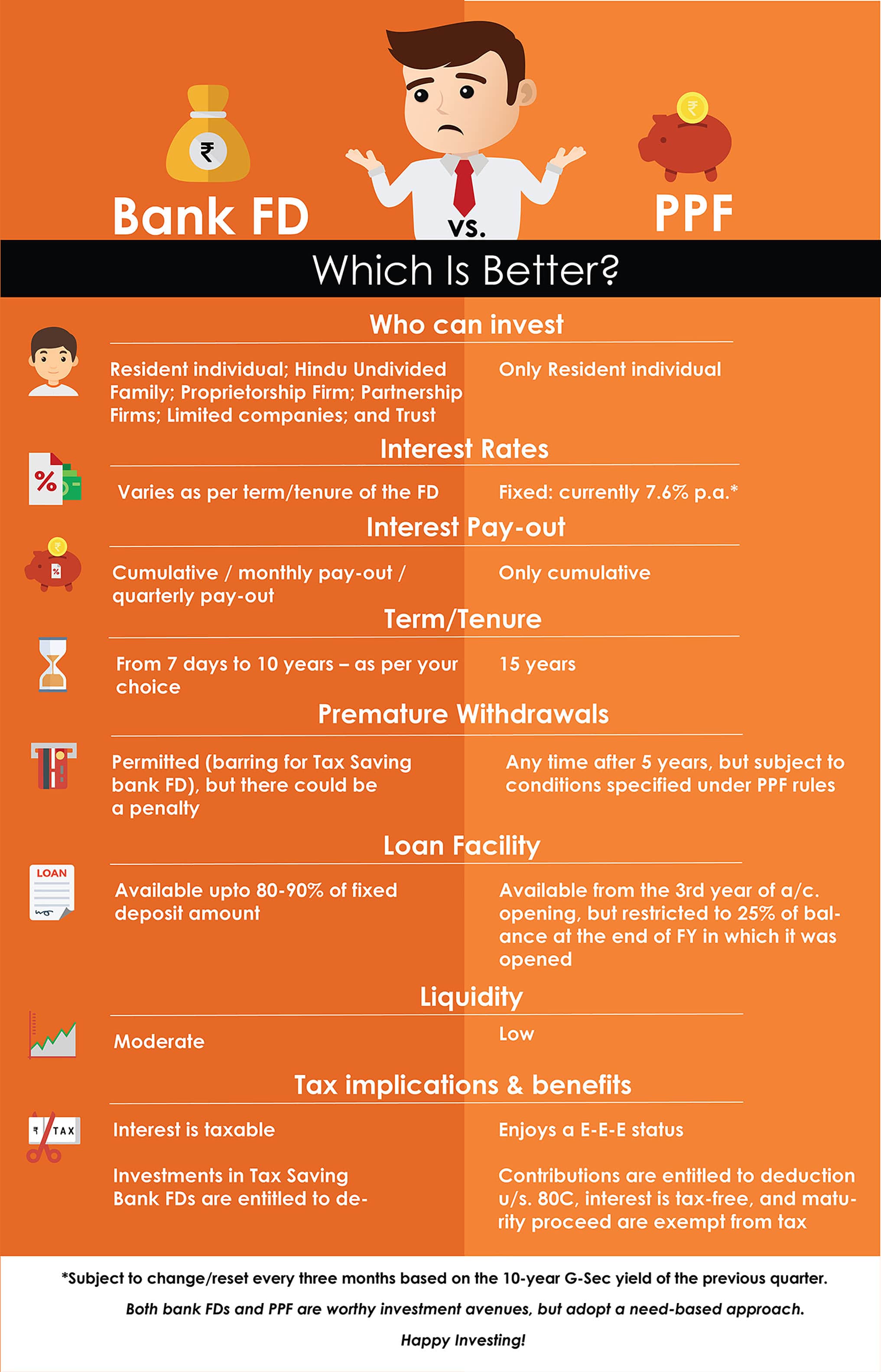Investing in any investment avenue requires at least some basic know-how on you - the investors’ part. Simply going by what your distributors / relationship managers / agents say can do more harm than good to your hard-earned money. That is why it is imperative for you to exercise a certain degree of self-learning and be responsible for your investments.
This should be an exercise even if you are investing in the most common investment instruments such as a bank’s fixed deposit or Public Provident Fund (PPF). You may have heard about these instruments from your family, friends, neighbours, etc. To invest in a bank’s FD, for your convenience, banks provide the facility of directly debiting your savings account for a pre-determined amount and transferring it to an FD linked with it.
Surely, Bank FD and PPF are the most accepted investment avenues by investors averse to risk.
Let us understand what these products are.
What is a Bank Fixed Deposit?
Bank FDs are term deposits where the investor makes a lump sum investment. It is the most traditional form of investment in India. Wherein your money is debited from the savings account and locked in for a fixed tenure at a specific rate of interest which is higher than what you earn on savings account. This gives you the flexibility to park your money as per your need.
What is a Public Provident Fund?
Public Provident Fund (PPF) is a scheme of the Central Government, framed under the PPF Act of 1968. Briefly, the PPF is a government-backed, long-term small savings scheme initially started by the Government to provide retirement security to self-employed individuals and workers in the unorganized sector.
These two products have proved to be the most popular investment avenues for Indian citizens.
Now that you know what and how these products work, let us learn more about their features and what makes one better option over the other.

- Investment Amount
The maximum amount which an individual can invest in PPF account is Rs 1,50,000 per annum. The minimum one can invest is Rs 500.
Conversely, there is no upper limit to the investment amount in bank fixed deposits.
- Interest Rates
At present, the rate of interest on a 1-year bank FDs offered by most of the banks ranges from 5% to 7.50% per annum. You can earn the interest on monthly, quarterly and annual basis.
The Interest rate on PPF tracks the yield of the Government’s 10-year benchmark bond. This move was intended to keep bank deposits competitive. Often banks blamed Government-run Small Savings Schemes (SSS) such as PPF and National Savings Certificates (NSCs) for making their deposits uncompetitive. The PPF interest from January 1, 2018 is set at 7.60%.
- Maturity or Lock in Period
There is no lock-in period for bank FDs. And maturity of the FD ranges between 7 days to 10 years.
However, your money in PPF account is blocked for the first 5 years and matures only after 15 years. If you are keen on a safe investment, a decent rate of return, tax benefits (deduction and tax free interest), and have a long term investment horizon, PPF is for you. It is a disciplined investment avenue as your money is blocked for 15 years.
- Premature Withdrawals
Most of the banks give you the flexibility to withdraw the money from fixed deposits before maturity. However, some banks also charge a penalty on premature withdrawal. Hence, read the fine-prints in the application form before you invest.
On the other hand, you are eligible to withdraw money any time after the end of the fifth year from the date the initial subscription is made. This is an amount of not more than 50% of the previous year’s balance or the fourth year, immediately preceding the year of withdrawal, whichever is less. You cannot make more than a single withdrawal in the year. You need to apply with Form C for any withdrawals.
- Tax Benefit
PPF fetches you a decent rate of return which is tax-free at maturity and the contributions you make, too, are eligible for a tax deduction under Section 80C of the Income-Tax Act, 1961. Effectively PPF still enjoys an Exempt-Exempt-Exempt (E-E-E) status. So, if you are keen on a safe corpus, earning a decent tax-free rate of return, enjoying tax benefit; PPF is for you. The current maximum deduction available is Rs 1,50,000 per annum.
On the contrary, the interest earned on FDs is taxed as per one's income tax slab on accrual basis. If the interest amount exceeds Rs 10,000, the bank would deduct tax at source (TDS) at the rate of 10% p.a. However, the FD with 5 year maturity qualifies for income tax deductions and hence you will not pay any tax.
- Loans
Most banks do offer an overdraft facility on your fixed deposit. You can avail for a loan upto 90% of your fixed deposit amount. The interest charged for such loan is comparatively lower as compared to personal loans.
A loan facility is available on a PPF account too. The first loan can be taken in the third year of opening the account. For example, if the account was opened during the year 2010-11, the first loan can be taken during the year 2012-2013. The loan amount will be restricted to 25% of the balance, including the interest for the year 2010-11 in the account as on 31/3/2011. The loan must be repaid in a maximum of 36 EMIs, i.e. three years. You can take a second loan against your PPF account before the end of your sixth financial year, but your second loan can be taken only once your first loan is fully settled.

PPF or FD: Which Between the Two Should You Invest in?
PPF and FDs both can be used as long-term savings instruments. But, keep in mind your liquidity needs, interest rate scenario, risk profile, investment objective and inflation before investing your hard-earned money in these instruments.
FDs offer easy liquidity which is not available in PPF. But even while investing in an FD, take a well-thought out approach and analyse the product in detail. Read the terms & conditions clearly before investing in it. On the other hand, to utilise the tax benefits offered, you can opt for a PPF account facility.
PersonalFN believes that the availability and the need of funds should determine which investment avenue you should opt for.
Remember, to make the best of these investments, you need to wisely choose your investment avenues. Do not be lured by sales pitch of your relationship manager/ investment advisor. Adopt a need-based approach toward your investing. Set S.M.A.R.T. goals and ensure your investing in various asset class with both a long and short term investment horizon in mind.
Since the beginning of 2015, the Reserve Bank of India (RBI) has reduced policy rate by 175 basis points (bps). Consequently, banks, too, have reduced interest rates on Fixed Deposits (FDs). If inflation mellows down further, the rates are expected to drop lower.
Such a scenario has got many investors, especially the ones averse to risk worried. They’re wondering where they should park their hard-earned money. Their returns further get eroded when inflation – which is hovering around 5% -- is accounted for over the past year. So, the effective real rate of return (also known also as inflation-adjusted return) has clearly become unimpressive.
Therefore, many investors are exploring various investment avenues looking for better returns. And at such times we believe debt mutual funds will be suitable if you are a conservative investor. But remember, debt funds aren’t completely risk-free. Debt funds carry mainly interest rate risk, credit risk, and liquidity risk. Plus, when selecting debt funds, your investment horizon and risk profile matters. If you have an investment horizon of 3 to 6 months, ultra-short term funds (also known as liquid plus funds) are most suitable. And if you have an extreme short-term time horizon (of less than 3 months), you would be better-off investing in liquid funds. For an investment horizon of upto 2 years, consider investing in short-term debt funds. Dynamically managed bond funds for an investment time horizon of 2-3 year can be appropriate provided you’ve rightly recognised where interest rates in the economy are headed.
If you’re looking at comprehensive mutual fund portfolio service we strongly suggest you subscribe to FundSelect Plus and benefit from the SEVEN time-tested, readymade equity and debt mutual fund portfolios. Based on your risk profile and investment horizon, you can choose out of three equity portfolios and three debt portfolios. In addition, you get a readymade tax-saving portfolio as well.
Don’t miss out on exclusive discounts available and Subscribe Now!
Hence, by investing in fixed deposit and PPF, you ensure that you have put your money to work with some amount of security. However, it takes years of toil to make the most of the money saved. To make your money work in most productive way you can invest into mutual funds and diversify your investments. You can also become your own financial planner by completing this e-learning course.
Add Comments